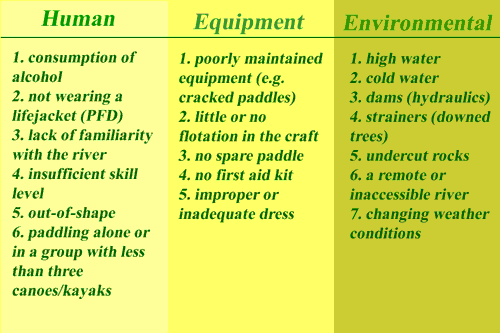Spotting a Potential Accident
River accidents don't just happen. They usually result from the interaction of a series of smaller events or misjudgements which culminate into a major accident. Experts analyze accidents in terms of their human, equipment and environmental factors. Usually, any one factor will not lead to an accident. However, the presence of three or even four factors in a paddling situation is a sign of serious trouble. In a sense, three strikes and a paddler may be out. The major factors that can lead to river accidents are:
 Planning a River Trip
Planning a River Trip
Specific planning must be taken seriously by paddlers in preparation for a float trip. The suggested guidelines that follow should give the paddler an insight into what is to be considered before attempting a cruise on a river.
Leaders preparedness and responsibility
1. Know the river or stream to be paddled. River guide booklets and topography maps are valuable references in trip planning. Have knowledge of the difficult parts of the trip and the location of any low head dams. Be aware of any possible changes in the river's level. One may want to plan alternatives in case the river/stream is too high or too low.
2. Setup locations for put-in and take-out along with a possible lunch break stop. Consider time and distance. Arrange for shuttle.
3. Participants. Limit the size of the group to a number that can be comfortably controlled. Designated group leaders should be experienced paddlers. Decisions on the participation of inexperienced boaters should be based on total group strength. Remember the welfare of the group is a major responsibility, and a balance of experienced paddlers with the less experienced will make for a more enjoyable trip.
4. Equipment. Plan so that all necessary group equipment is present on the trip.
5. Float Plan. If the trip is into a wilderness area, or for an extended period, plans should be filed with appropriate authorities or left with someone who will contact them after a certain time. The establishment of a late return phone number can save time and worry for everyone involved.
Participants Preparedness and Responsibility
1. Be a competent swimmer with the ability to handle ones self underwater and in moving water.
2. Be certain that you have a properly fitted Personal Flotation Device (PFD), and wear it .
3. Be suitably equipped.
4. Keep your craft under control. Control must be good enough to, at any time, stop or reach the shore before reaching any danger. Know one's boating ability. Do not enter a rapid unless one is reasonably sure that it can be navigated safely or that one can swim the entire length of the rapid in the event of a capsizing.
5. Be sure to keep an appropriate distance between canoes (distance will vary depending on water conditions; a good rule of thumb is to always keep the canoe behind in view). Never get ahead of the assigned lead canoe or behind the assigned sweep canoe. Both lead and sweep positions should be held by experienced paddlers with knowledge of the water being traveled.
6. Keep a lookout for river hazards and avoid them.
7. Respect the rights of fisherman and land owners while on your river trip.